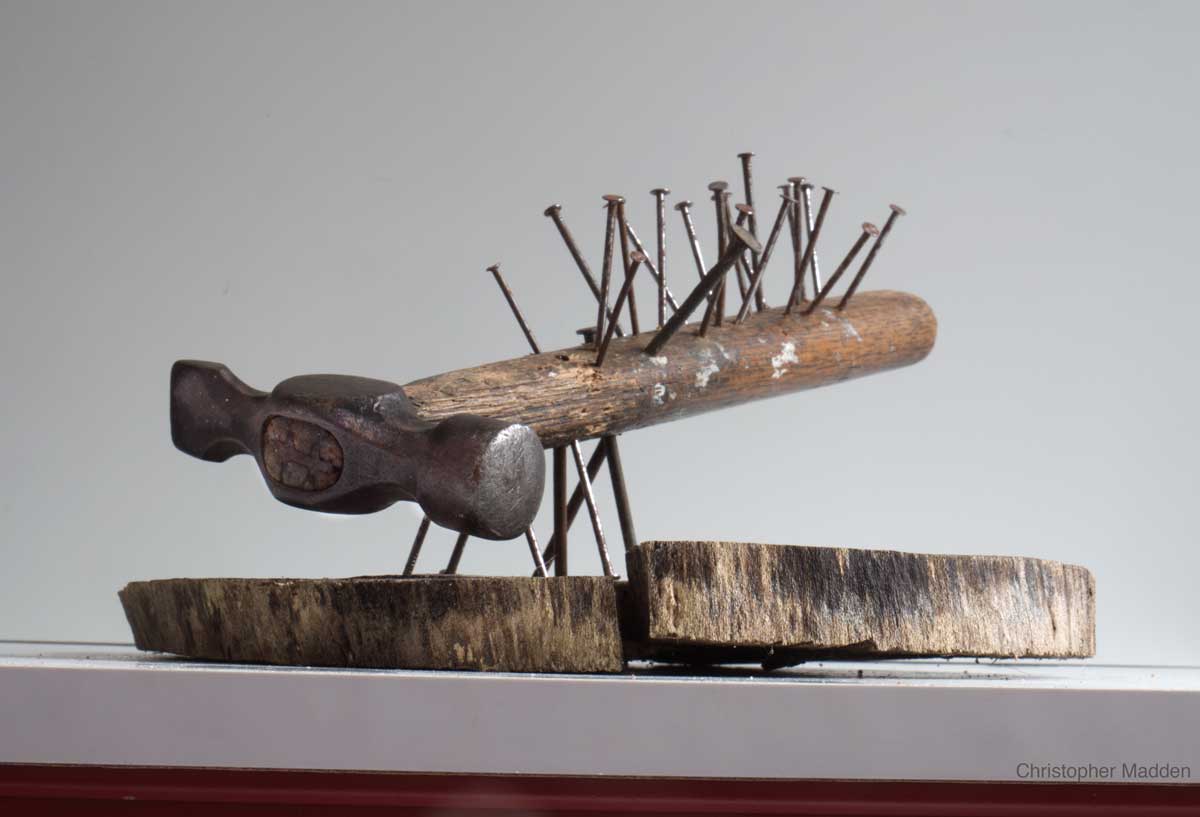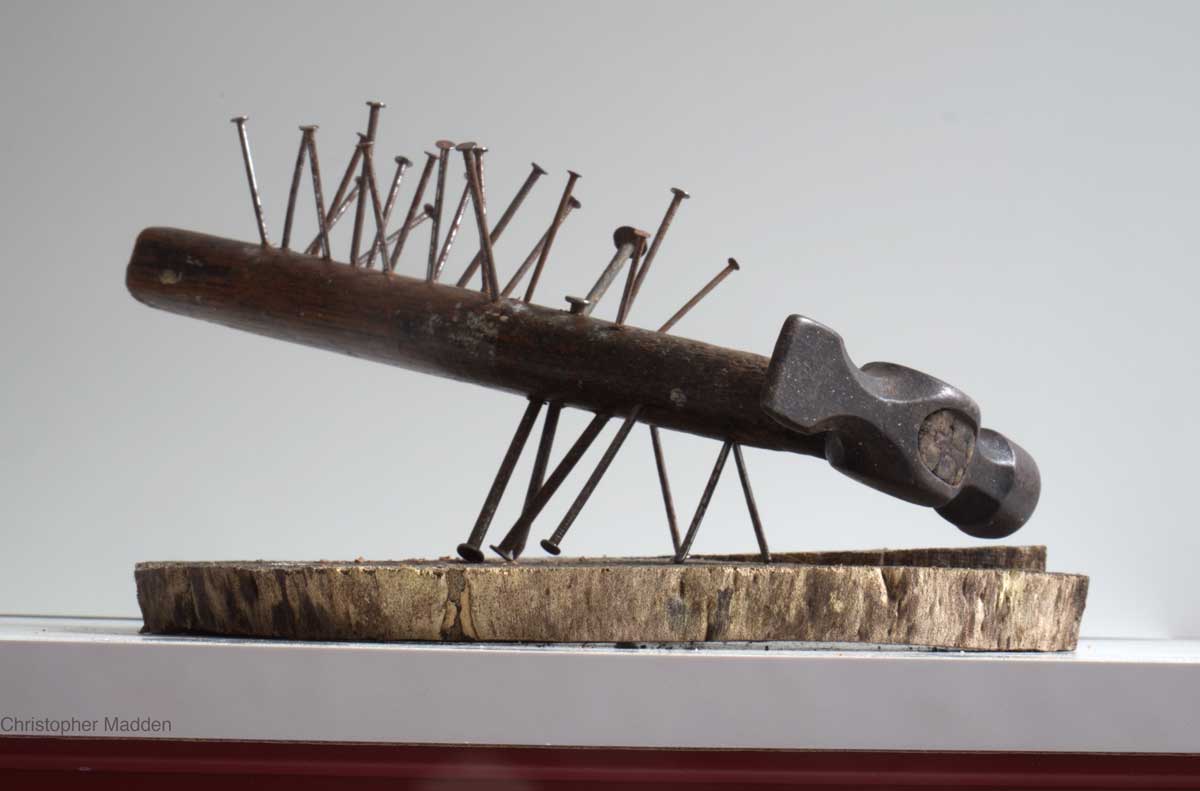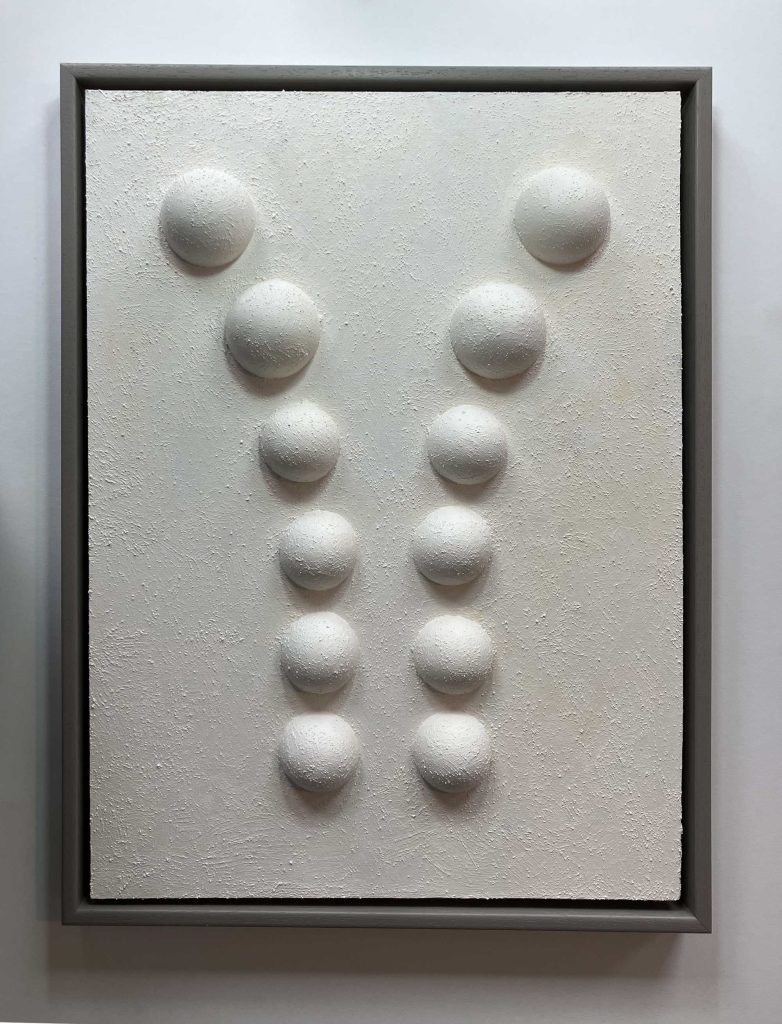
Abstract wall sculpture. Wood, plaster, sand, acrylic. 52x38x5cm. August 2025
Formation
An abstract wall-mounted sculpture composed of plaster hemispheres on board, painted with sand and acrylic paint.
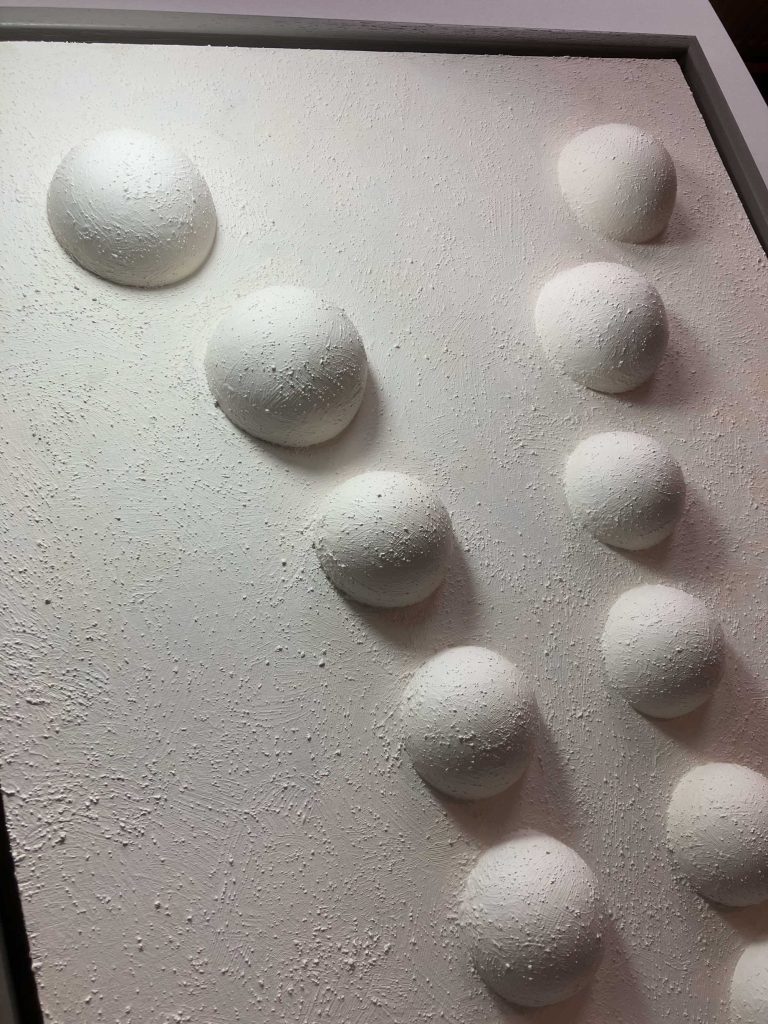
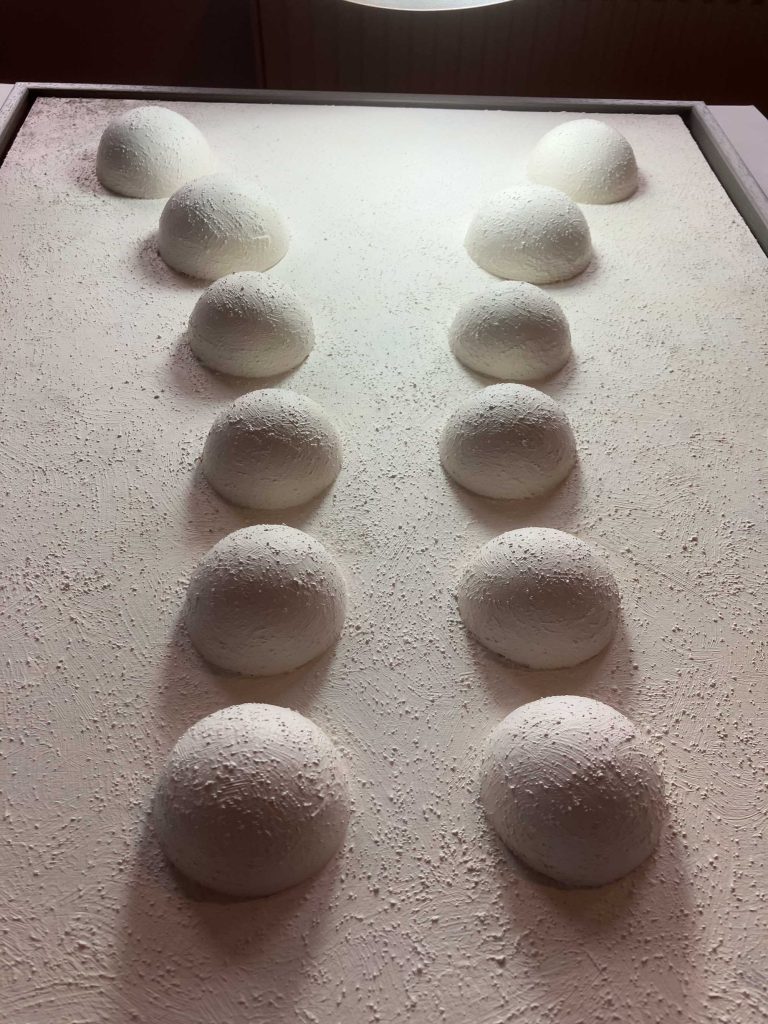

An abstract wall-mounted sculpture composed of plaster hemispheres on board, painted with sand and acrylic paint.


A sculpture created from two hammerheads, two ball bearings, six wooden hemispheres and length of card. The parts are held together by magnets.
The central components of this work are two hammerheads – artefacts that have been recurring features of my work for many years, usually in the form of drawings and more recently in the form of small scale sculptural work, The hammerheads are usually, but not always, used to represent the heads of people or animals.
…….
Hemisphere sculpture.
A close-up of the surface of an artwork from my series featuring protruding and recessed hemispheres in flat surfaces.
This particular artwork is a wall hung sculpture filmed while lying horizontally. The interesting light effects are created by sunlight passing through trees. The texture of the artwork is created by mixing sand with gesso.
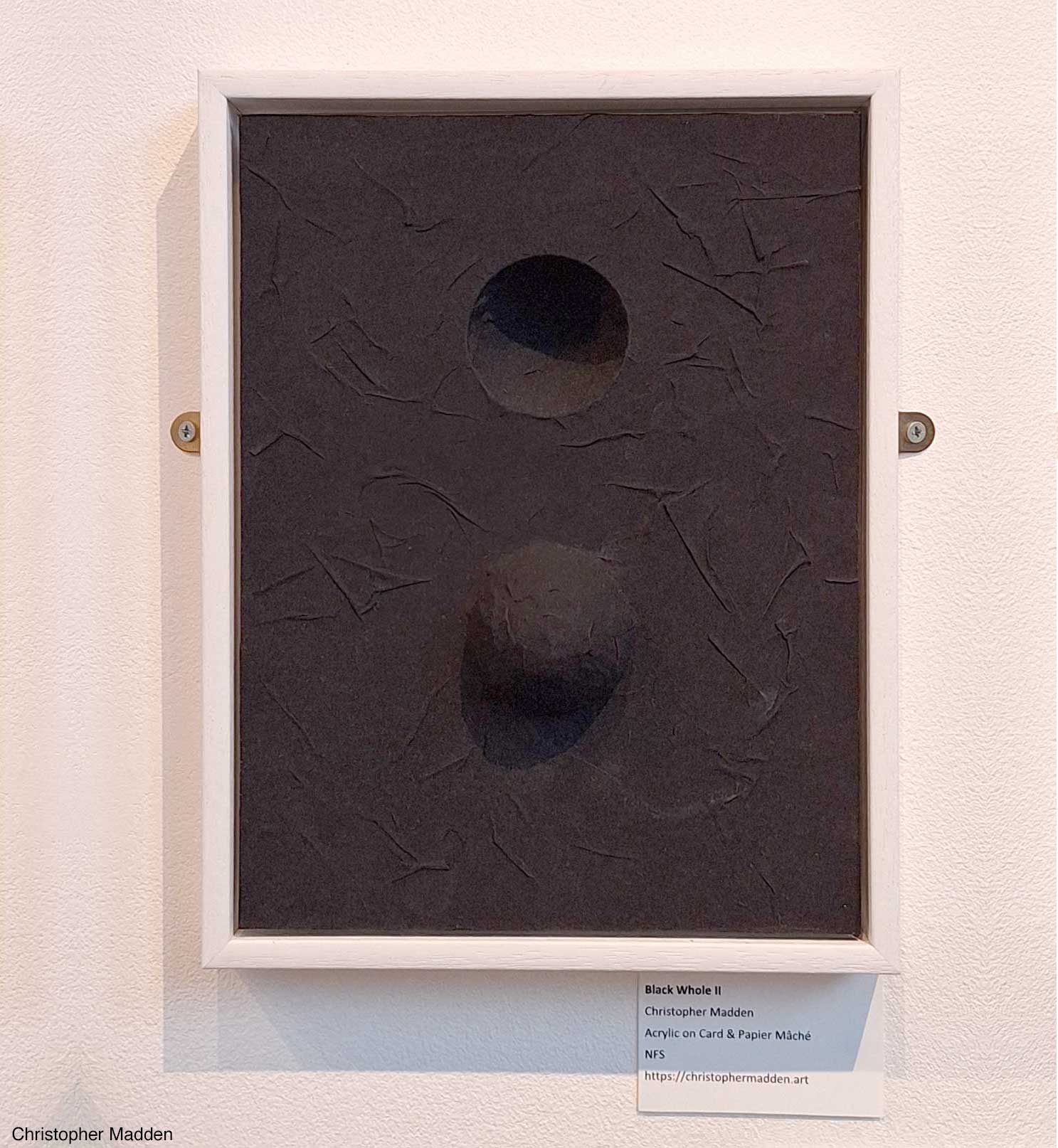
Exhibited at Shrewsbury Museum and Art Gallery, July and August 2025.
A work in my Black Whole series.
The works feature a hemispherical form protruding from the plane of the work and an equal and opposite hemispherical form receding into it.
The work was concieved partly as a visualisation of the positive and negative forces that underlie the physical structure of the universe. The concept is that at the most fundamental level of physical reality nothing exists except what can be thought of metaphorically as a flat featureless plane or surface. This featureless plane represents the existence of “nothingness” and is represented in the artwork by the flat surface of the work. A single disturbance to this plane creates a paired bulge and depression (just as a single wave creates a peak and a trough), represented in the work by the raised hemisphere and the recessed hemisphere.
The bulge and the depression are equal and opposite, so they can be thought of as cancelling each other out. As a result they add nothing to the “energy” at this fundamental level of reality. The fundamental plane is still. on average, flat. So, although something exists (in the form of the bulge and the depression), on average nothing still exists. The creation of ‘something’ does not alter the existence of nothing.
Nothing exists.
The work is painted very matt black to allude to the existence of nothing.
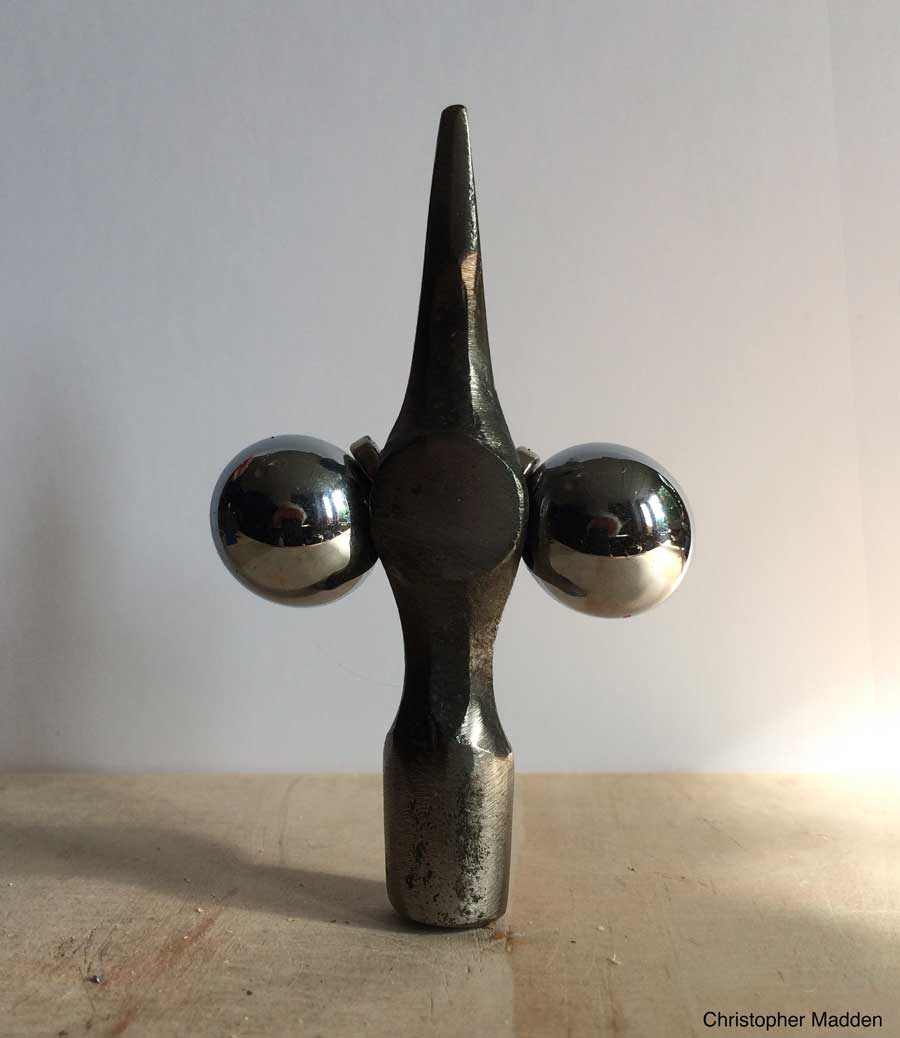
A sculpture composed of the head of a cross pein hammer with two steel spheres attached to its sides.
Hammerheads standing on end have an interesting anthropomorphic quality to them. This anthropomorphism is exploited in this work to create an ambiguous form.
The work possibly suggests a human figure with spheres in the place of arms. Or it could suggest the head of a creature such as an insect with the spheres as huge eyes.
The steel spheres are attached to the hammerhead by magnets.
A sculpture of assemblage composed of blocks of wood and rusty nails salvaged from an old builder’s pallet.
An example of up cycling in contemporary art.
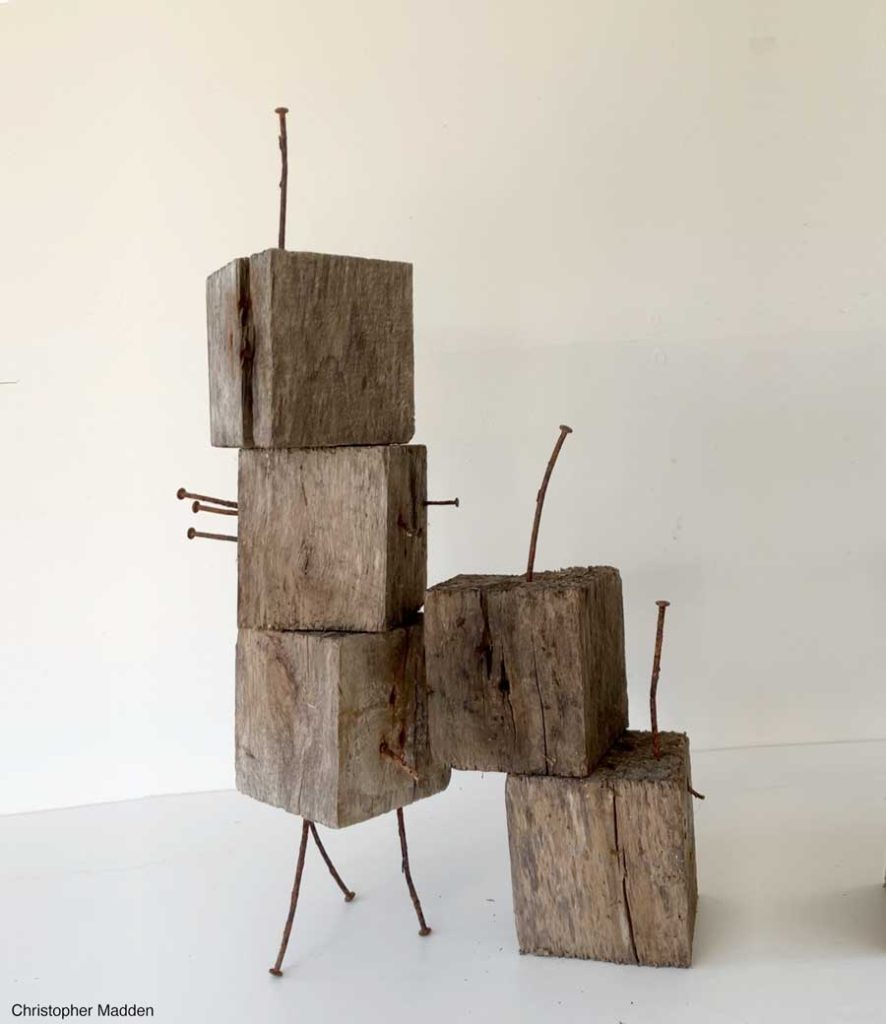
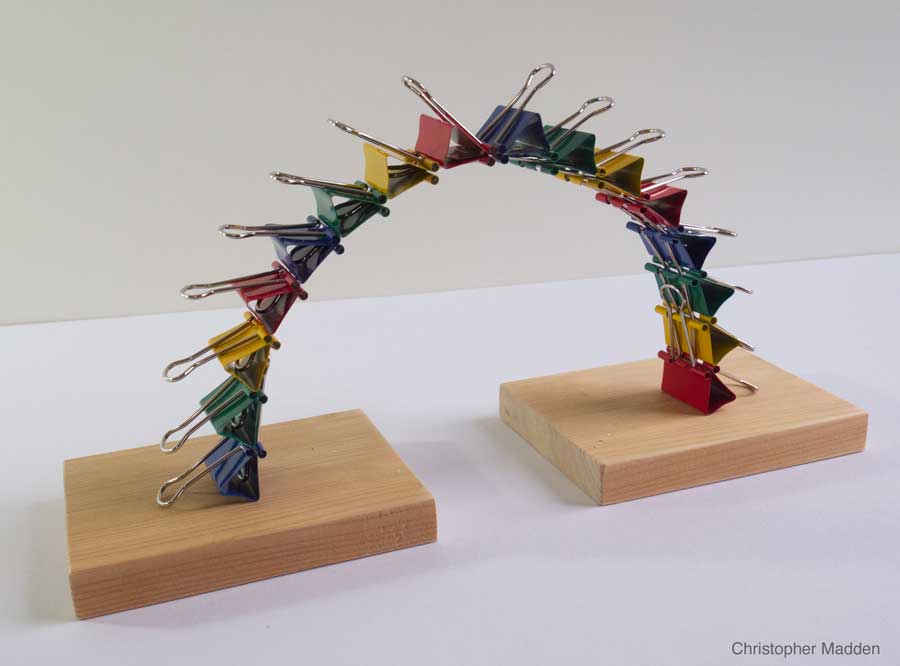
A sculpture composed of document clips that grip each other to form an arch or bridge. The bridge spans the gap between two pieces of wood on which the document clips stands.
Part of the concept behind the assemblage is that the arch of clips literally bridges the gap between the two separate parts of the base. The linked clips represent the concept of achievements that can only be made by cooperation with others (In this case with other document clips). It’s a metaphor for communication and cooperation.
The fact that the clips are in a variety of different colours is significant, as it represents diverse types of people cooperating. The colours aren’t meant to signify any particular quality of diversity such as race or sexuality, just diversity in general.
It’s quite a literal sculpture, conveying a straightforward concept. It’s also a simple and elegant form. Simple in form and simple in concept – that makes a change.
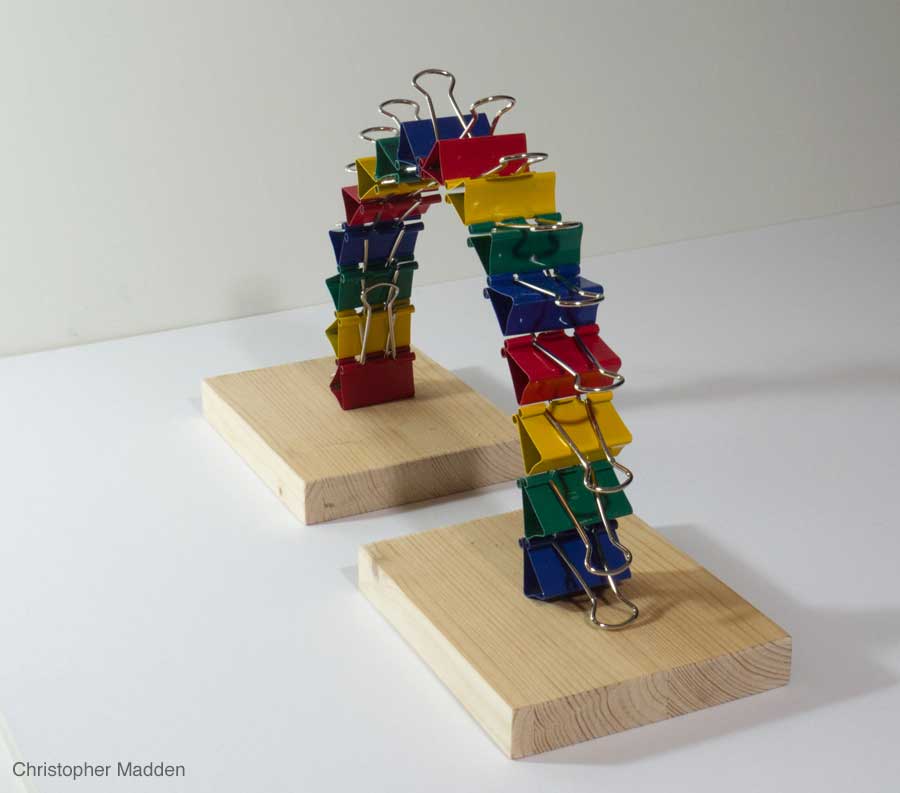
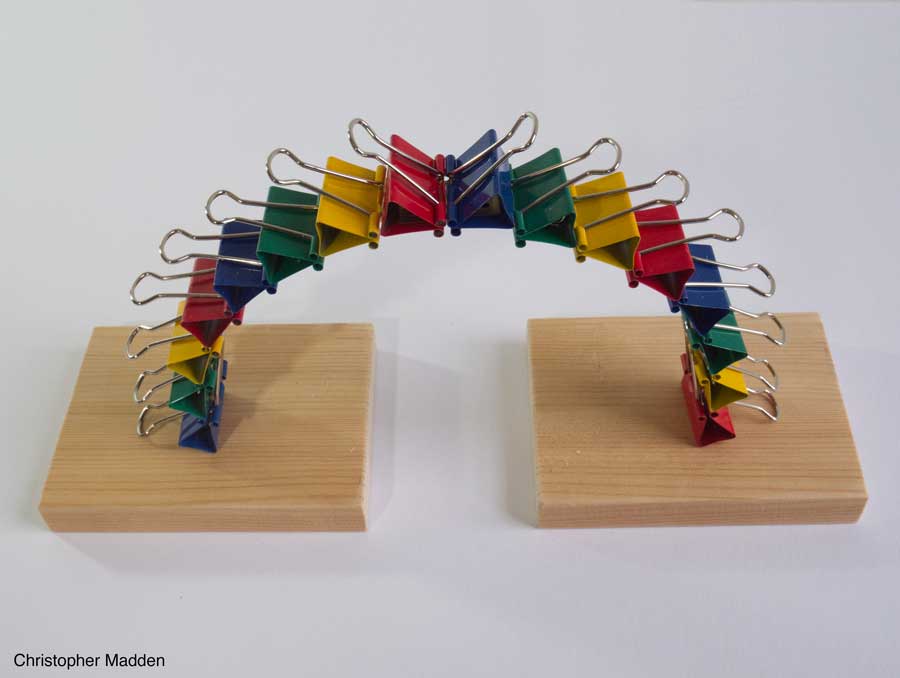
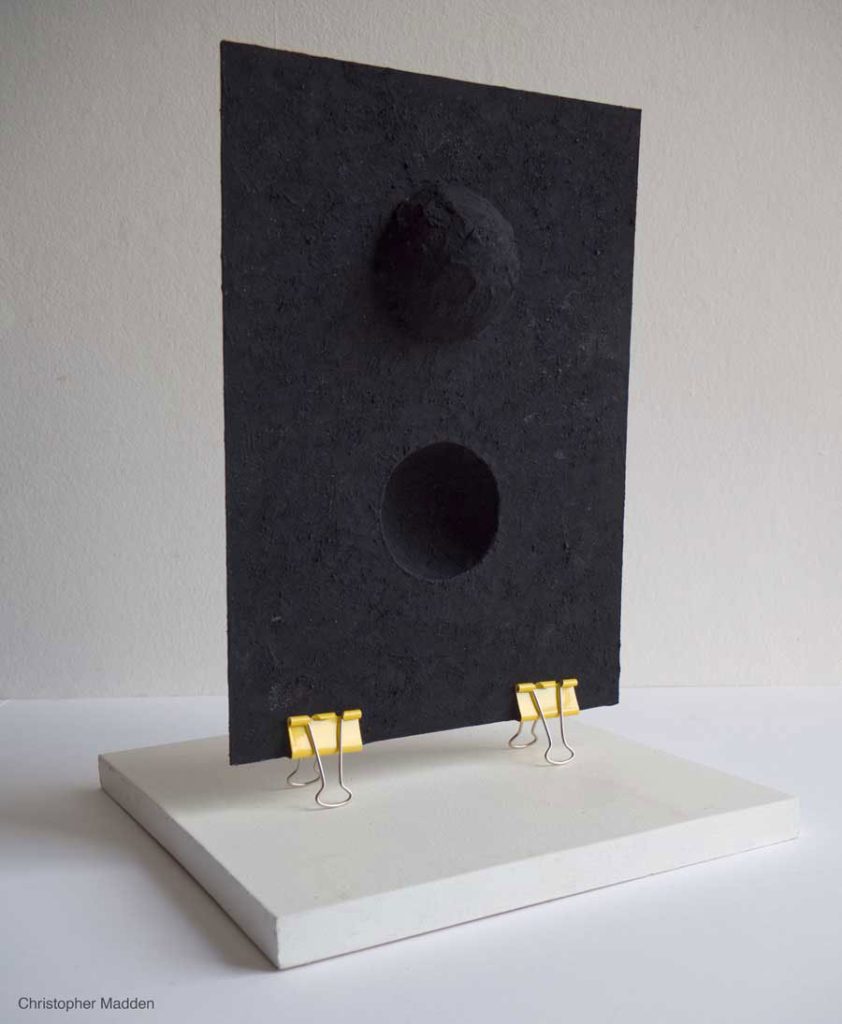
This work was displayed in the Royal West of England Academy, Bristol exhibition Paper Works, 2025.
A sculpture composed of two hemispheres on a flat surface, with one of the hemispheres protruding from one surface and the other protruding from the other surface. Both hemispheres are hollow, so that relative to each surface of the flat card one hemisphere protrudes and the other creates a hollow. The sculpture is coated with very matt black acrylic paint (Stuart Semple Black 4).
The matt black colour of the sculpture makes the form deliberately difficult to read. This is especially the case with the hollows (possibly because the brain is not expecting there to be hollows in the surface).
On one level the work can be viewed as a simple intriguing puzzle that engages the viewer’s perception and cognition in interpreting the positive and negative forms that are generated by the hemispheres.
The work also has a metaphorical interpretation that relates to my interest in science.
In this interpretation the flat black surface of the sculpture can be thought of as representing the ‘base state’ of physical reality. Think of this state as being flat and featureless – a state in which nothing physical can meaningfully be said to actually exist – maybe the ‘resting’ state of the universe. Perhaps think of it as being comparable to a graph in which the line of the graph flatlines along the zero value of the x axis, indicating that there’s nothing to measure.
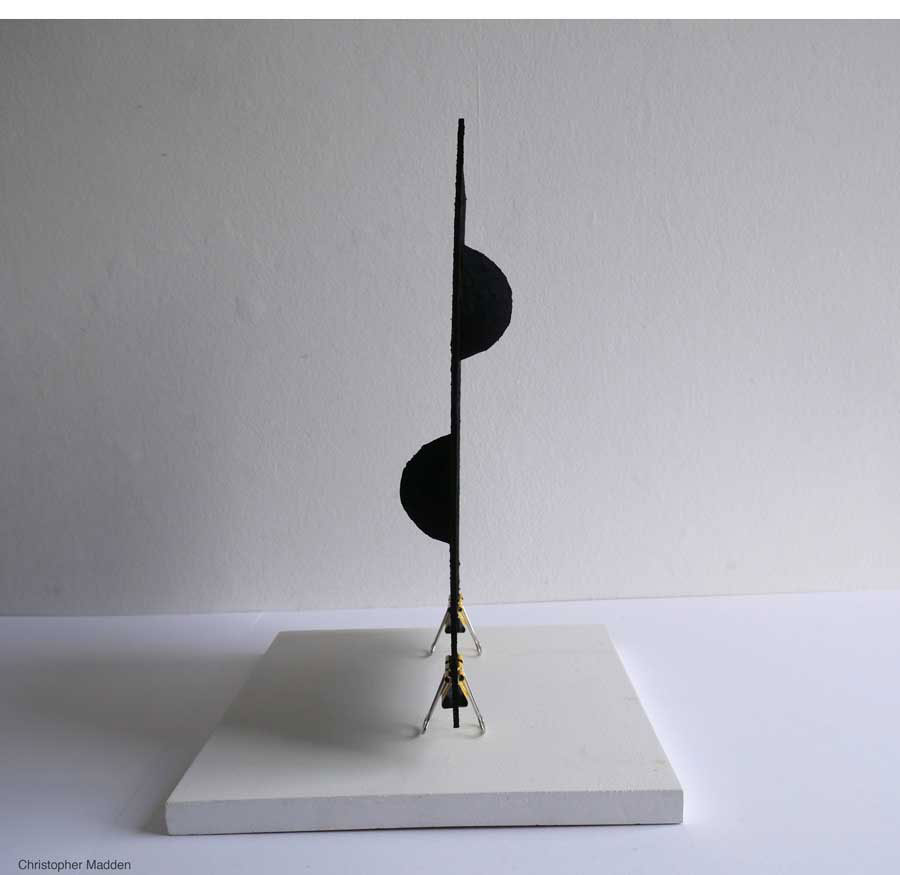
The two hemispheres in the sculpture disrupt the flat surface, creating the existence of form. Returning to the graph analogy, this is similar to the presence of two blips on the flatlining graph, with one blip going up and the other going down.
Because the hemispheres are hollow the pair create a bulge and a depression on each side of the flat surface, with the one that forms a bulge on one side of the sculpture forming a depression on the other side.
On either of the two sides of the flat surface, in terms of total volume, the bulge of one of the hemispheres and the depression of the other cancel each other out, with the negative volume of the depressed hemisphere cancelling the positive volume of the protruding one.
This can be thought of as an analogy for the physical nature of the universe at its most fundamental level. The flat featureless surface of the sculpture represents the flat featureless ‘surface’ of the fundamental universe when it is devoid of matter and when nothing exists other than the ‘surface’. The pair of hemispheres conceptually represents a single fundamental ‘disturbance’ in the flat fearless surface, a single simplest element of existence perhaps analogous to the most fundamental of fundamental particles.
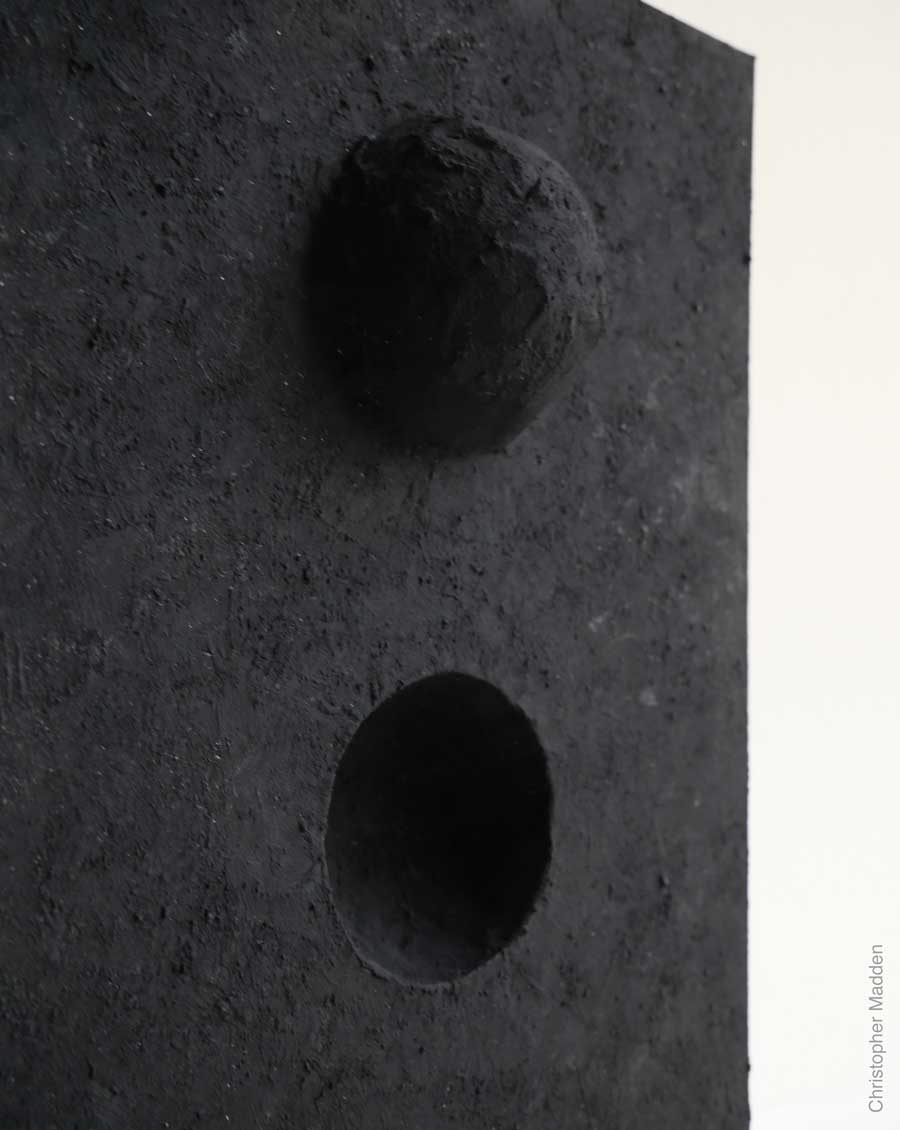
Importantly, because this fundamental disturbance is represented by two identical forms (the hemispheres) of which one has positive volume and one has negative volume which cancel out, the total volume of the disturbance is zero. This is analogous to the physical universe arising out of a state of nothingness (the flat surface) yet adding nothing to the volume, thus adding nothing to nothing.
So, although the universe exists it is still composed of nothing.
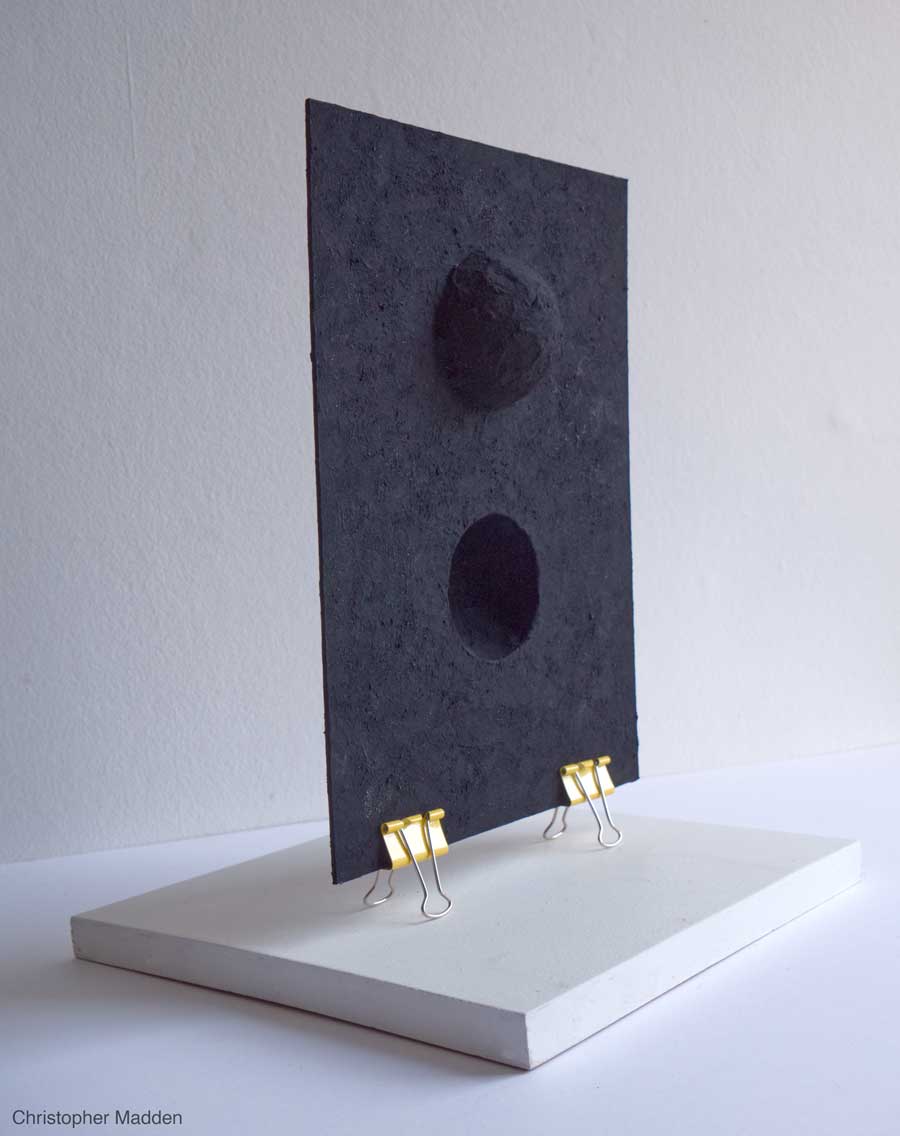
This work reflects my interest in both art and science (I started out on a scientific career before moving over to an artistic one).
I believe that art and science are often much more closely linked than is often assumed. There is for instance a huge amount of aesthetics in the appreciation of mathematics, and the study of the way that our senses make sense of the world is nothing if not a science.
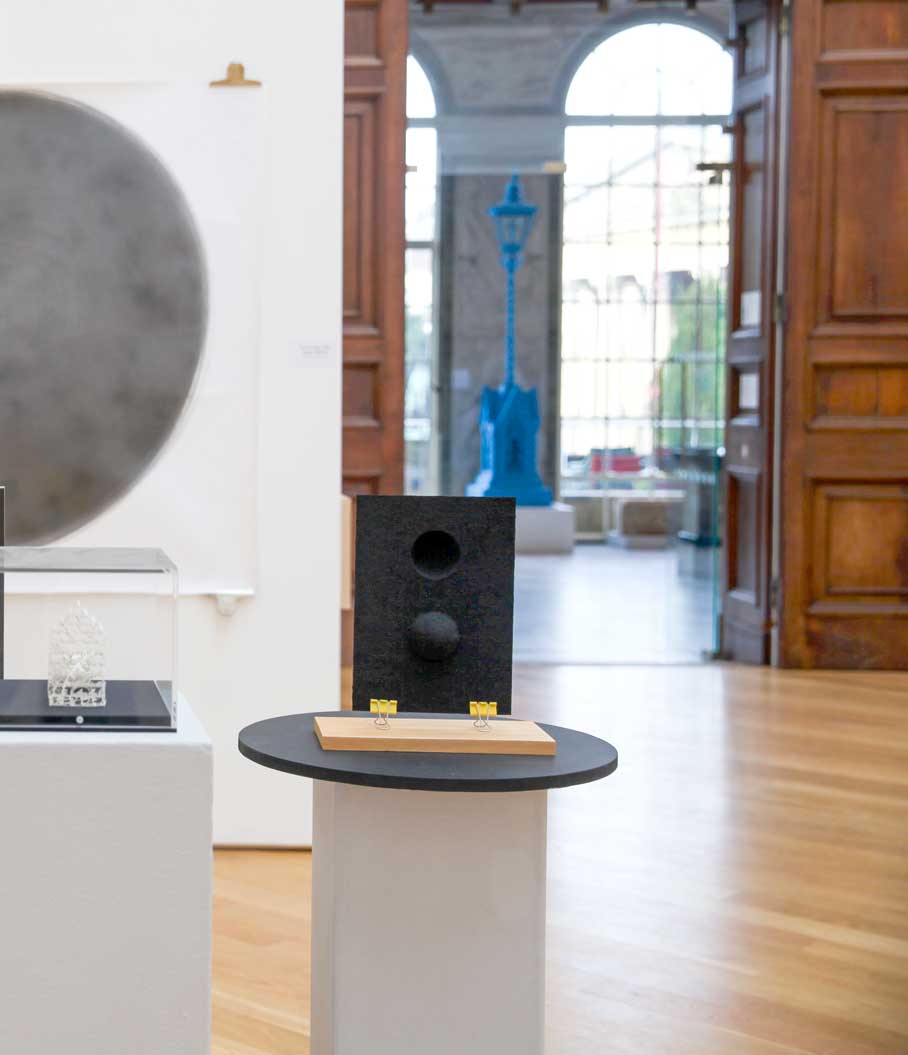
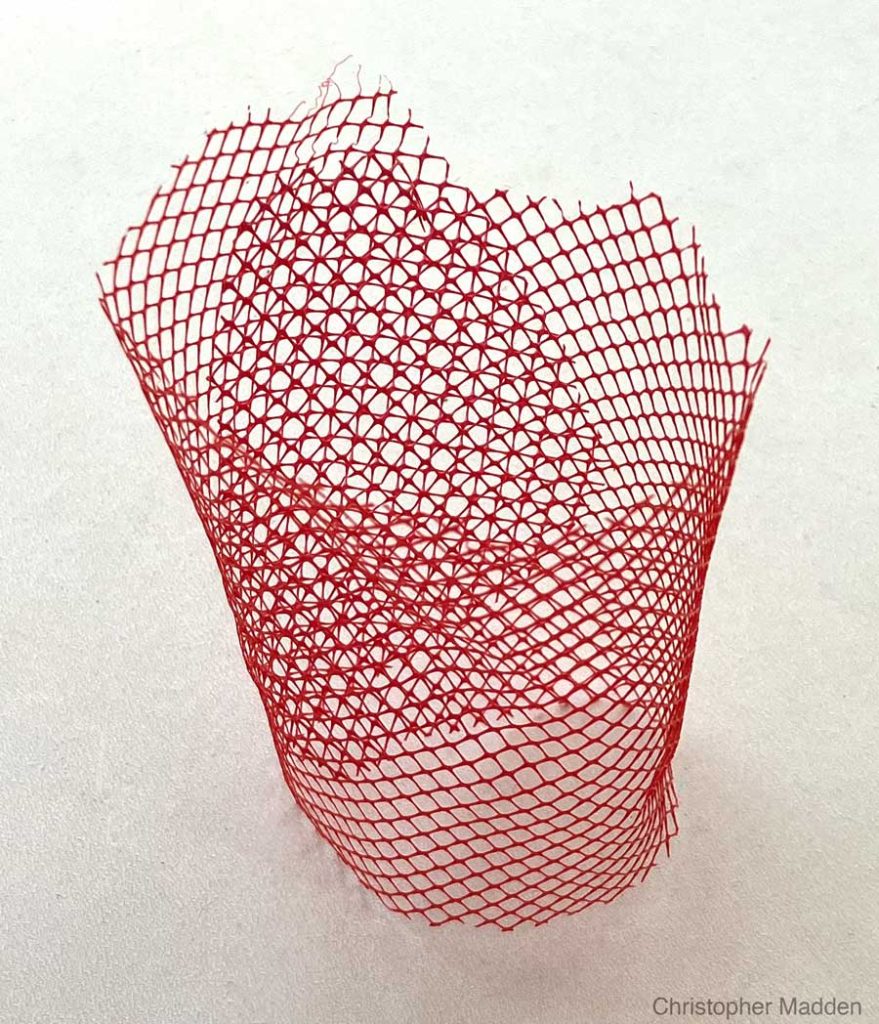
The work consists of a sheet of plastic mesh from the packaging for a pack of oranges.
I particularly like this piece because of the mundanity of its material.
I’ve been experimenting with the generation of moiré patterns and related optical effects for many years, often involving the interaction of digitally generated simple grids such as in the example below from 2008 or as seen here .
I’ve previously used the same sort of plastic mesh to create moiré patterns in an exhibit in my solo exhibition at Tremenheere Sculpture Gardens in 2022.
The term moiré pattern or moiré fringe comes from a type of French fabric called moire, in which two layers of fabric are pressed together to form a single sheet in which the slight misallignment of the fabric’s mesh generates patterns.
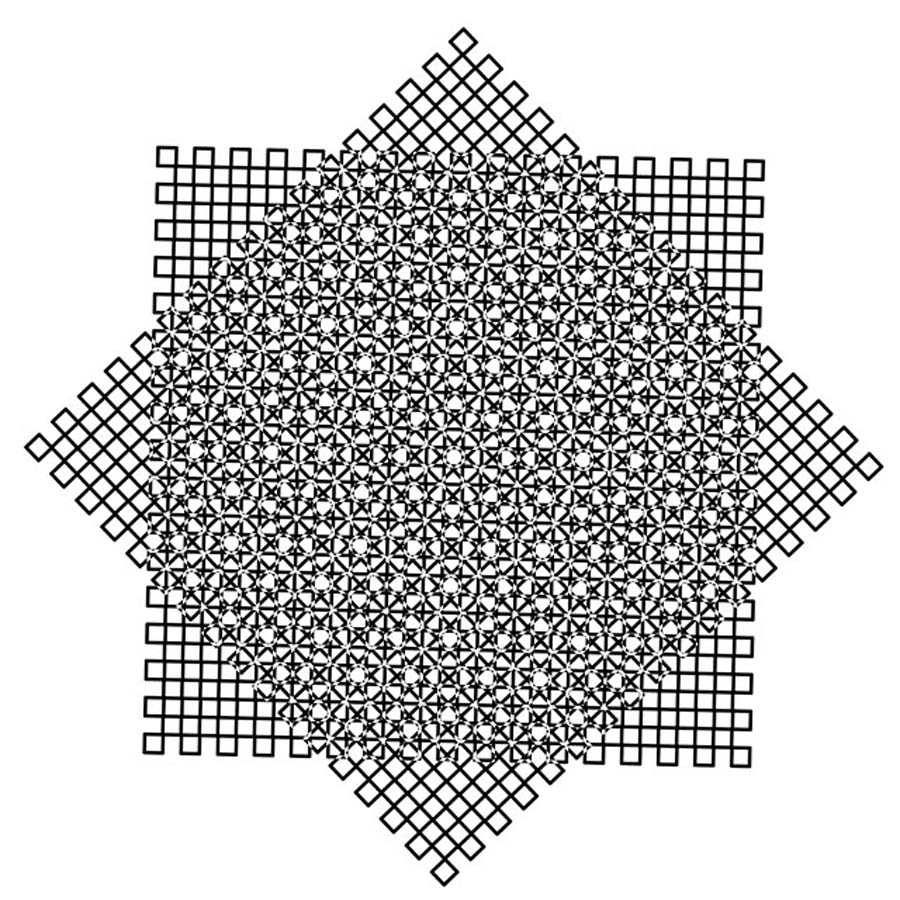
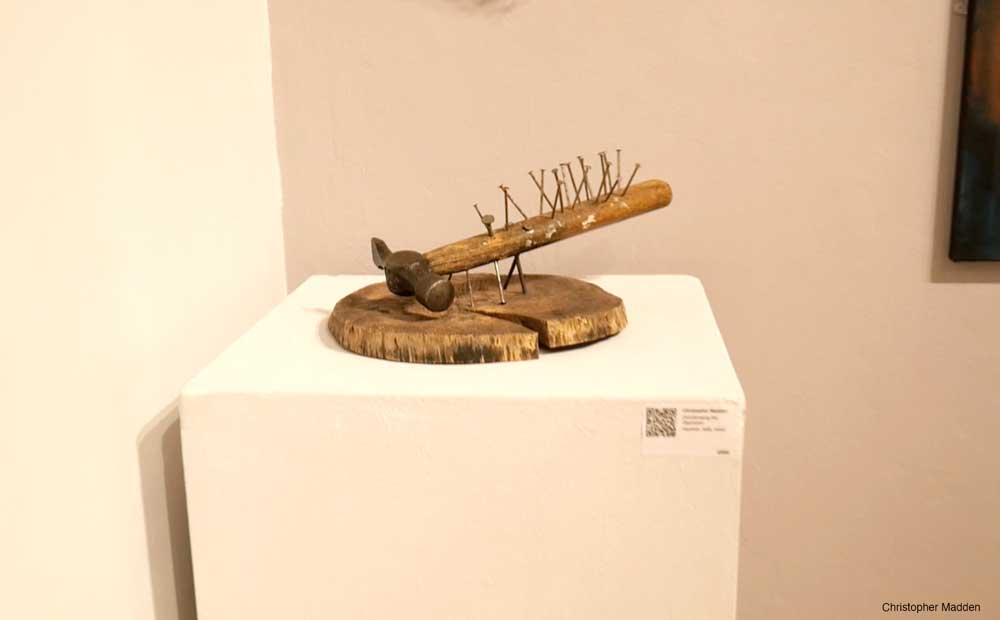
Shown in the ING Discerning Eye exhibition in the Mall Galleries, London, November 2024.
This sculpture, composed of a hammer and nails, symbolises the act of the oppressed overthrowing their oppressor. The nails represent the oppressed and the hammer represents their oppressor.
The metaphor raises a few questions . How did the nails become driven into the hammer? By another hammer? If so, is that other hammer a potential oppressor? Is the (unseen) second hammer just an oppressor in its own right, simply using the nails for its own ends?
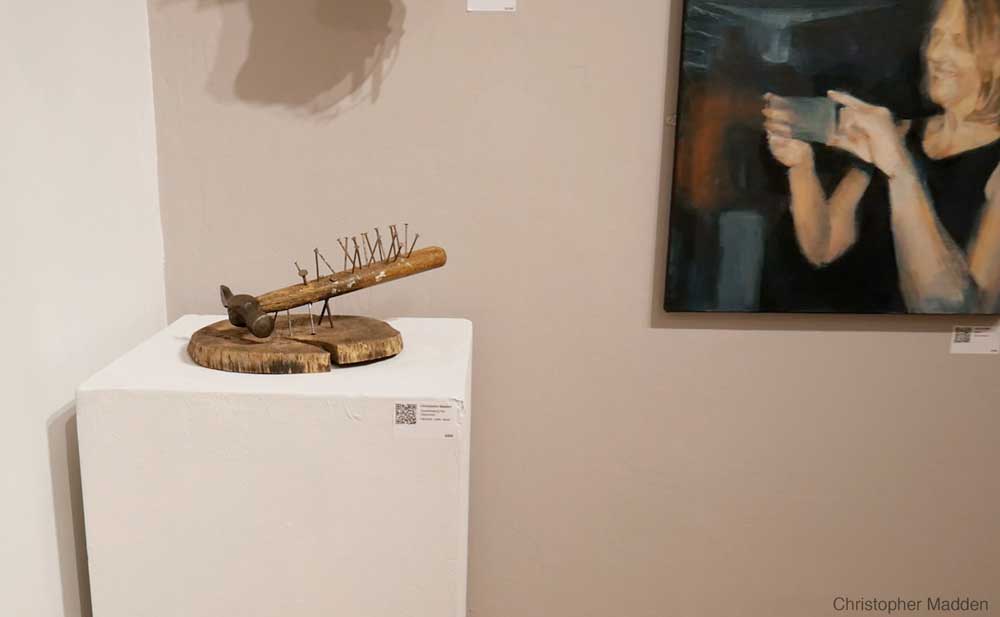
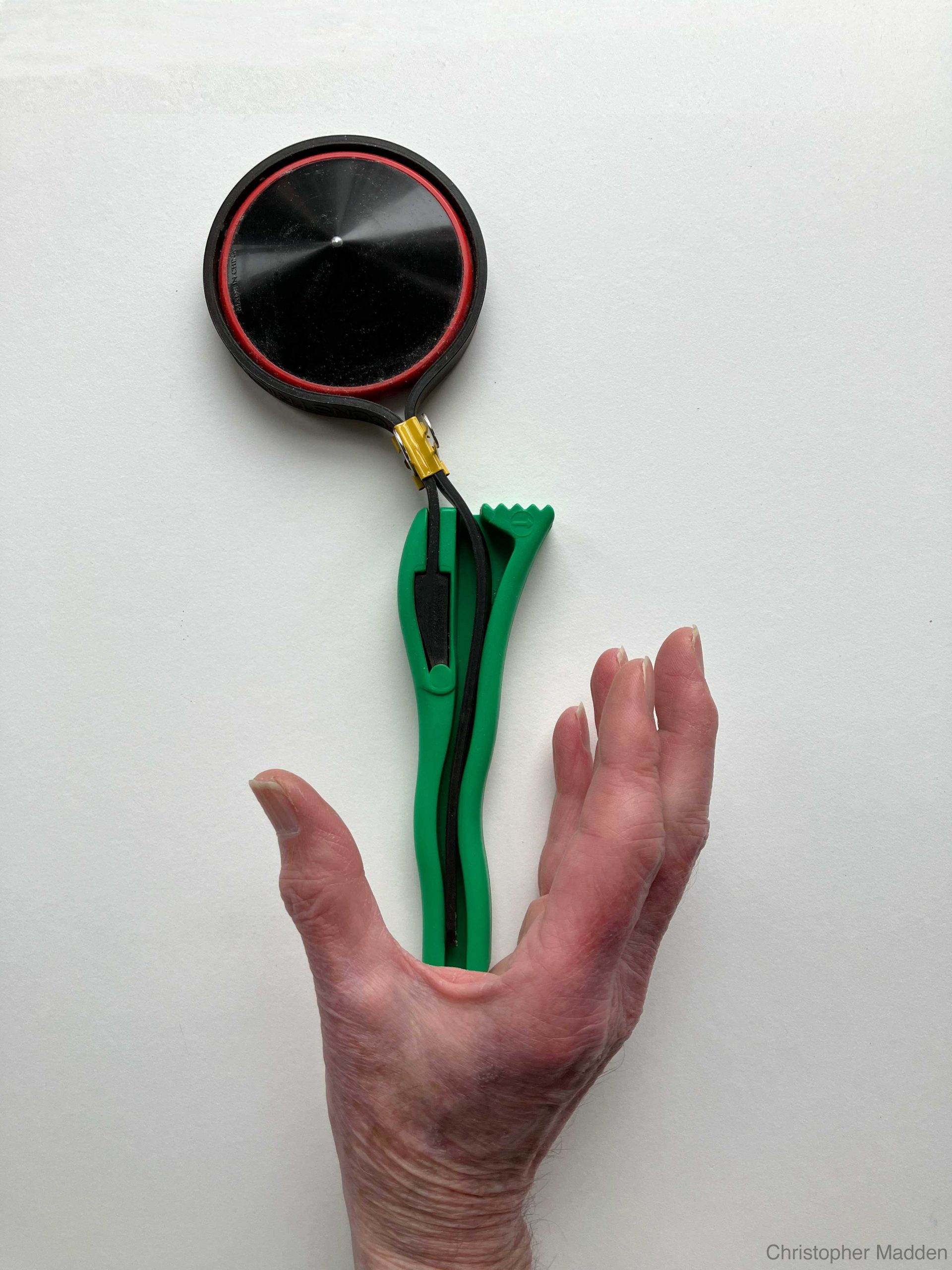
An assemblage of household items (a jar opener, a spinning top and a document clip). In the photograph the assemblage is paired with a human hand to create an ambiguous form. There are suggestions of a flowering plant, a human form or an apparatus with a wheel.
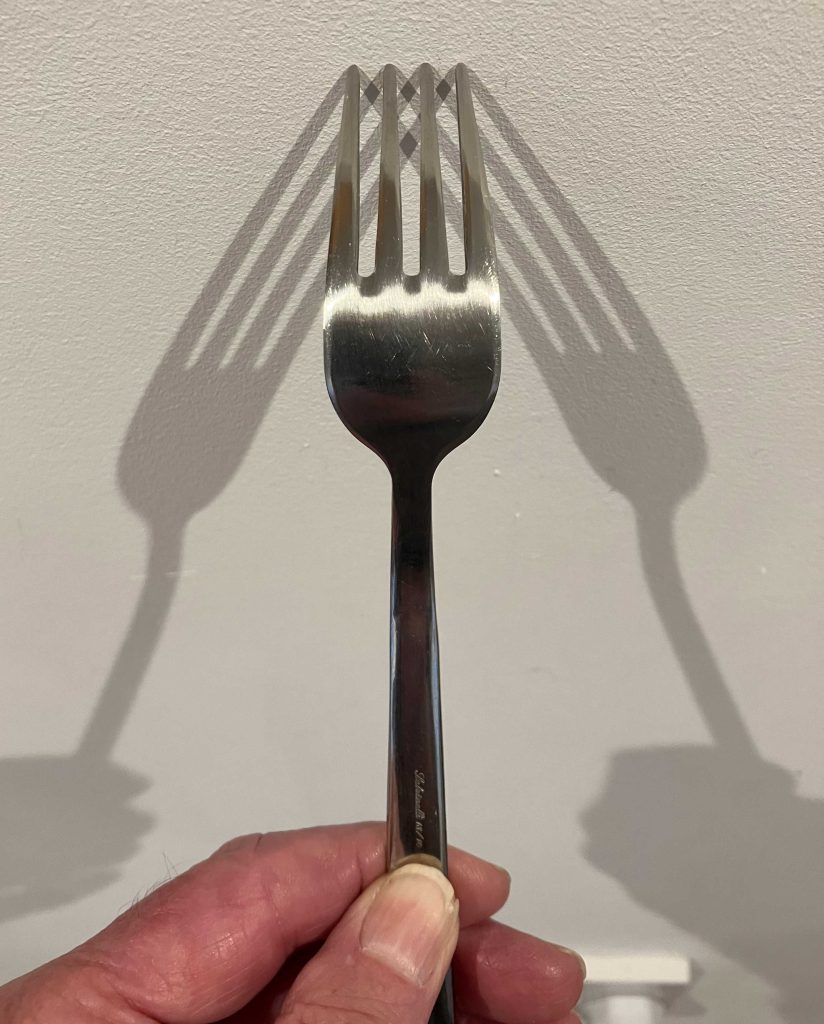
A spontaneously conceived piece of artwork created while I was putting away the washing up in the kitchen. The shadows are created by the ceiling lights.
This is a good example of finding inspiration anywhere and in mundane objects and mundane places, and of the importance of being open to inspiration striking at any time.
In some ways it’s a piece of readymade art, being basically a fork plucked from my dish rack, however the importance of the shadows also makes it into shadow art in which the cast shadows are as important as the object casting the shadows.
Who needs a studio when you’ve got a kitchen?
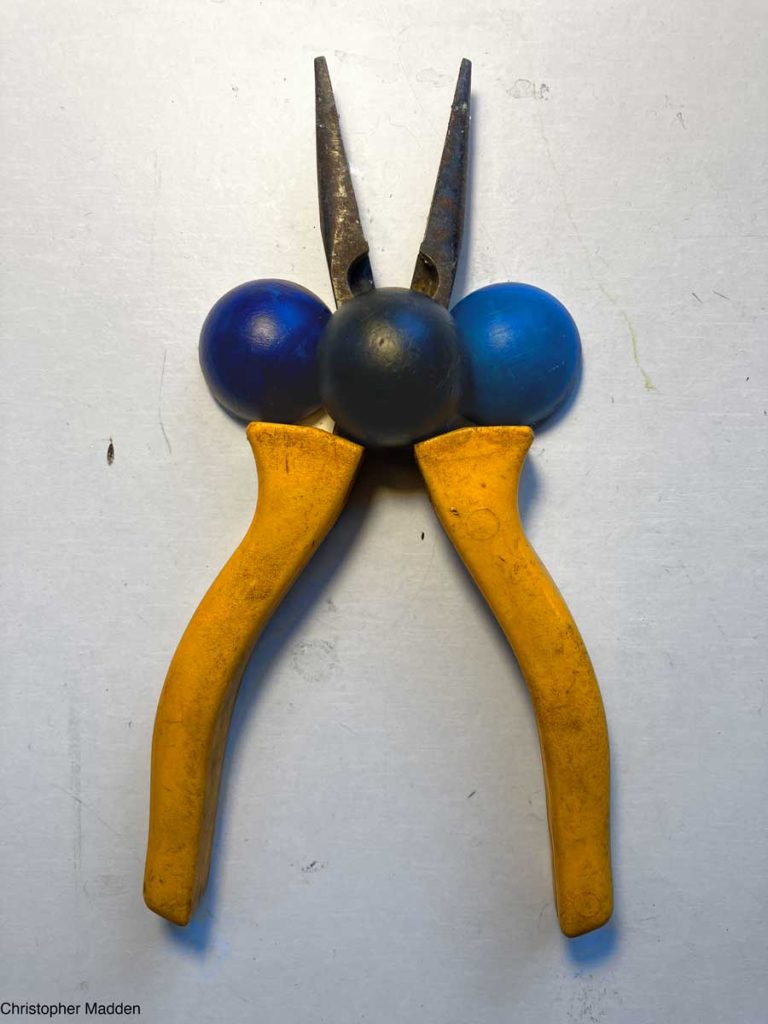
A work featuring a pair of workman’s pliers.
Workman’s tools and handyman’s tools are a frequent feature of my work, with my first sketches of them dating from my early twenties, about fifty years ago.
I’ve always liked the anthropomorphic and zoomorphic qualities of hand tools. Pliers, such as the ones here, have legs that are suggestive of human legs and jaws that are suggestive of crocodile jaws or perhaps pterodactyl jaws. The business end of tin snips and garden pruners resemble the beaks of birds, and hammers have heads.
Another appeal about hand tools is their robust usefulness. They tend to look strong and they make hard physical work that much easier.
They are also nostalgic. In my youth my father had a garden shed that contained racks and racks of tools that were in constant use for repairing broken household items and for constructing basic items of furniture. Now such tools feel as though they may be on the brink of extinction as people no longer fix things and as what tools there still are tend to be power tools which lack the simple physicality of hand tools
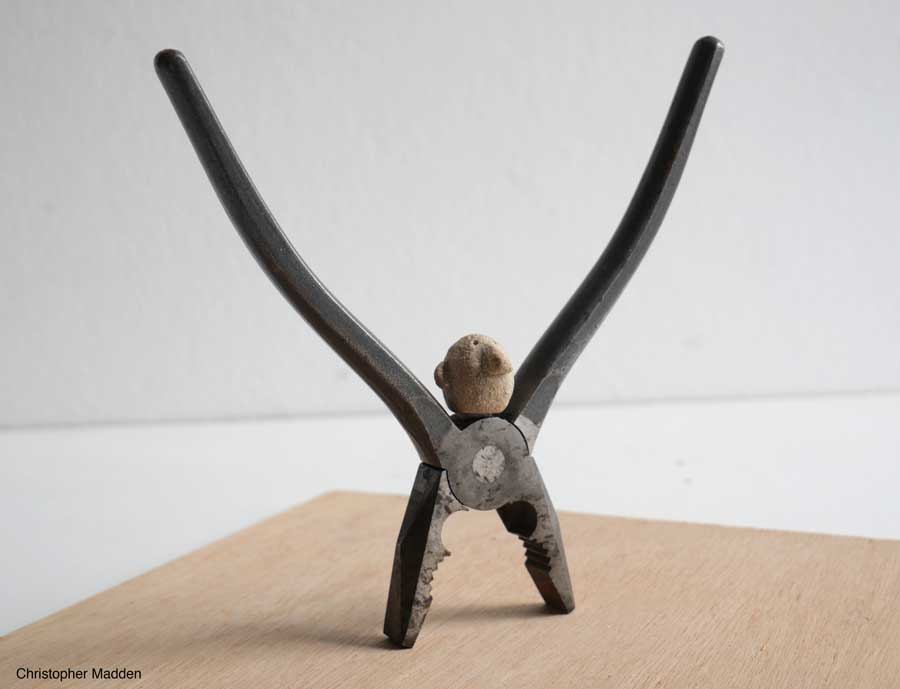
An anthropomorphic sculpture composed of a pair of pliers to which a ceramic head has been attached.
I made the head about thirty years ago in around 1994.
I call the piece Homo Habilis after the extinct species of human that lived in Eastern and Southern Africa about two million years ago. Homo Habilis literally means Handy Man, which in my piece nicely links to the handyman’s tool, the pliers. Homo Habilis is also referred to as ‘Man the Toolmaker’, which links equally nicely with the piece.
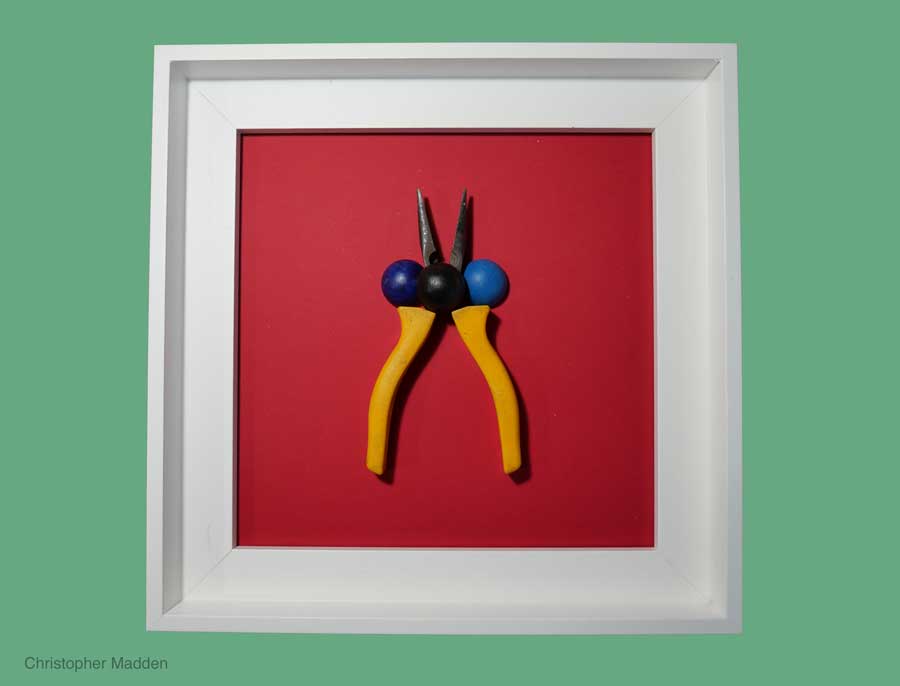
A pair of workman’s pliers mounted on coloured paper with three painted hemispheres of wood attached.
To me the pliers have a pleasing anthropomorphic appearance, with their handles resembling legs (here dressed in brightly coloured trousers or stockings).
The three hemispheres disrupt the shape of the pliers, visually separating the jaws at the top of the tool from the base. This is reinforced by the fact that these particular pliers have brightly coloured plastic on the handles (the trousers) which are there to insulate the user of the pliers from any accidental contact with live electricity.
The use of handyman’s or workman’s tools such as hammers, pliers and spanners is a recurring theme in my work.
A mirror-based artwork. It features a mirror mounted perpendicular to a coloured ground on which are mounted two hemispheres in different colours. The hemispheres are positioned so that the reflection of one hemisphere in the mirror precisely coincides with the position of the other hemisphere. This creates an intriguing effect when the viewer observes the work from different angles.
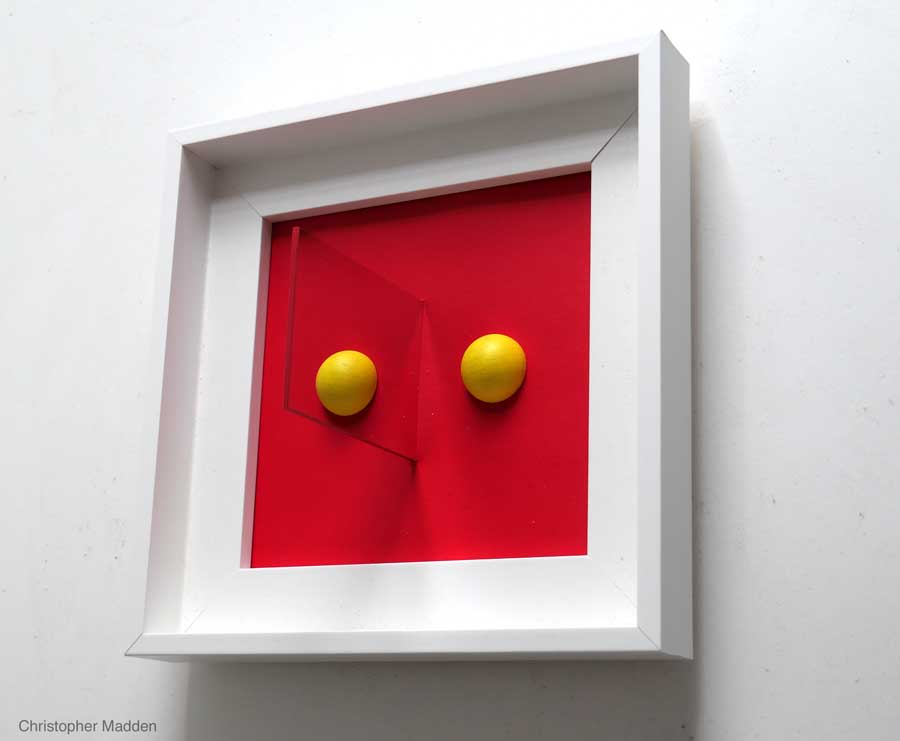
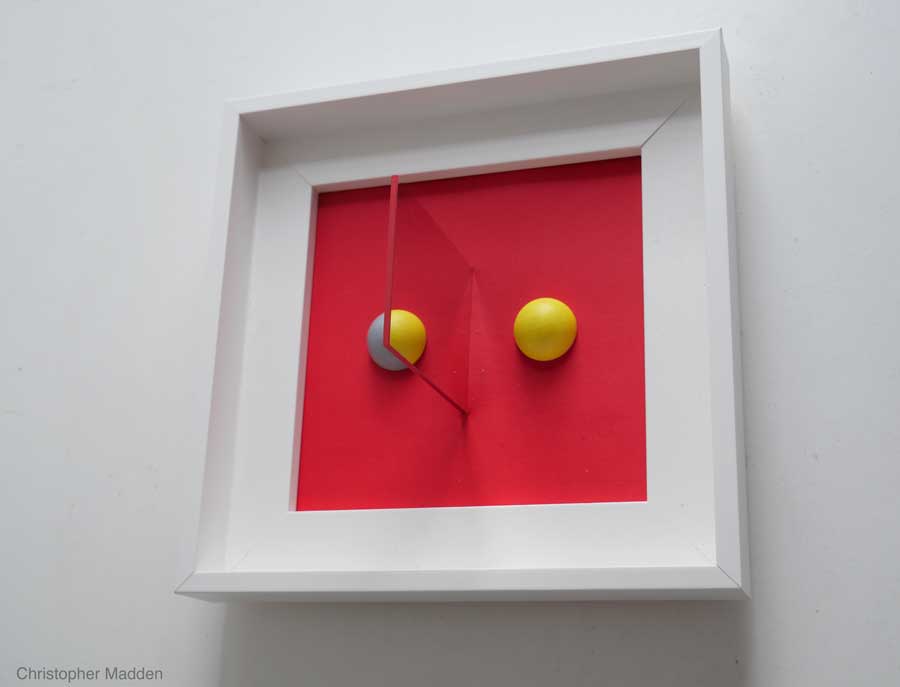
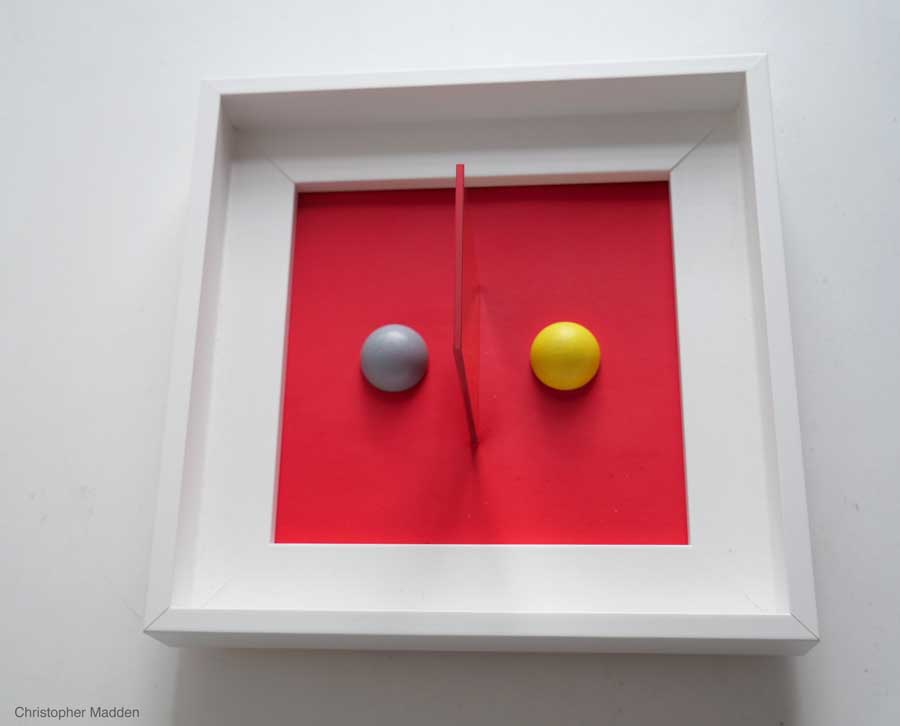
Mirrors are a useful device for the exploration of perception and the interpretation of what we see. I think this is partly because perfect reflections like those found in mirrors are almost nonexistent in the natural world other than when they are observed on stretches of water such as puddles, ponds and lakes in perfectly still conditions. When you look at a puddle, a pond or a lake you know exactly what you’re looking at, so your brain knows that the reflection in its surface is an optical effect, especially because the nature of the surface will usually be betrayed by the occasional ripple or the presence of a floating object such as a leaf or a duck.
Mirrors however are different. They can easily be placed in an artificial context in which the brain has to do a bit of work in deciding what it’s actually looking at. And to compound this, mirrors are almost always vertical (which the surface of a puddle or a pond never is). Put a mirror in a slightly unusual context and the brain can be deceived, which is a good avenue into the study of perception.
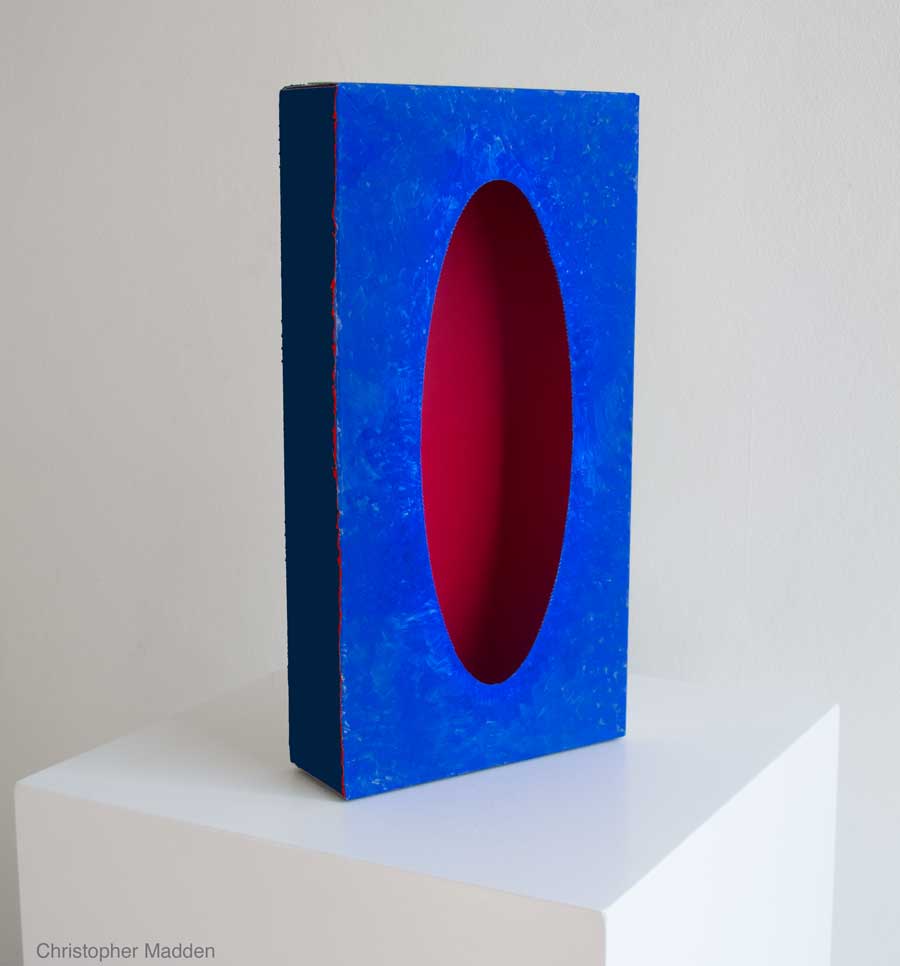
I’ve noticed several artworks recently that are modelled on the shape of tissue boxes. These include one in the recent 2024 Royal Academy Summer Exhibition (Mannanan by Brian Kneale RA) and a mention of them relating to the work of Florence Carr who is set to do a solo presentation at Frieze London 2024 this October.
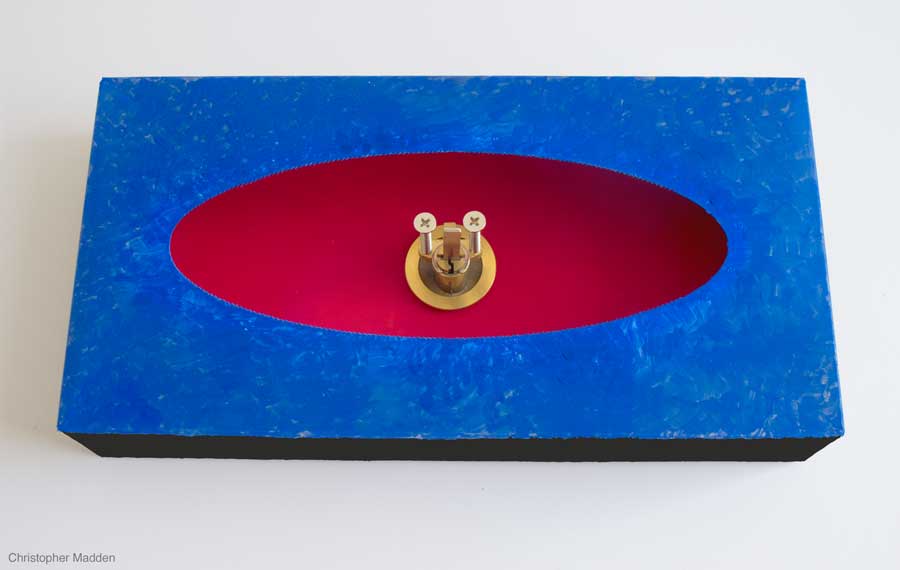
Above are a couple of photos of one of my own experiments with tissue boxes in which I painted an old tissue box blue on the outside and red on the inside.
My tissue box sculpture was probably inspired by seeing a large marble work by Anish Kapoor in the Royal Academy Summer Exhibition in (I think) 2021.
I very much doubt that the Anish Kapoor work was inspired by the shape of a tissue box, however once I’d seen the similarity I couldn’t get it out of my head, very much in the same way that once you’ve seen the shape of a human form in an abstract painting you can’t unsee it.
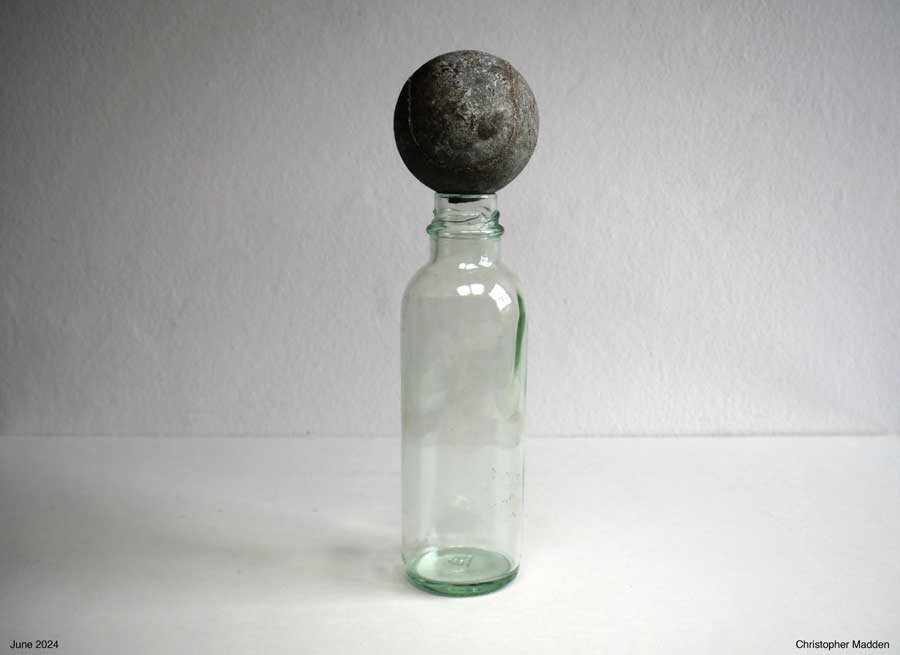
A sculpture composed of found objects.
The sphere that’s resting on top of the bottle is an old tennis ball that has lost all of its coating and that seems to have been left outside in the elements for a very long time. I think I found it in the garden, probably lost there by the previous owner of the property. Because of its colour, patina and texture it looks a lot more substantial than it actually is.
The shape of the bottle and the fact that the glass isn’t of uniform thickness suggests a vintage vessel, but it is actually a contemporary supermarket salad dressing bottle that was still being used for its original purpose the day before it was requisitioned for this sculpture. The salad dressing company were probably trying to tap into the current demand for artisan foodstuffs and consumer goods.
The found objects in this sculpture are unmodified and there is minimal physical input or compositional decisions that need making in the creation the work (The ball has to be place on top of the bottle, pure and simple). This probably makes the piece a form of readymade.
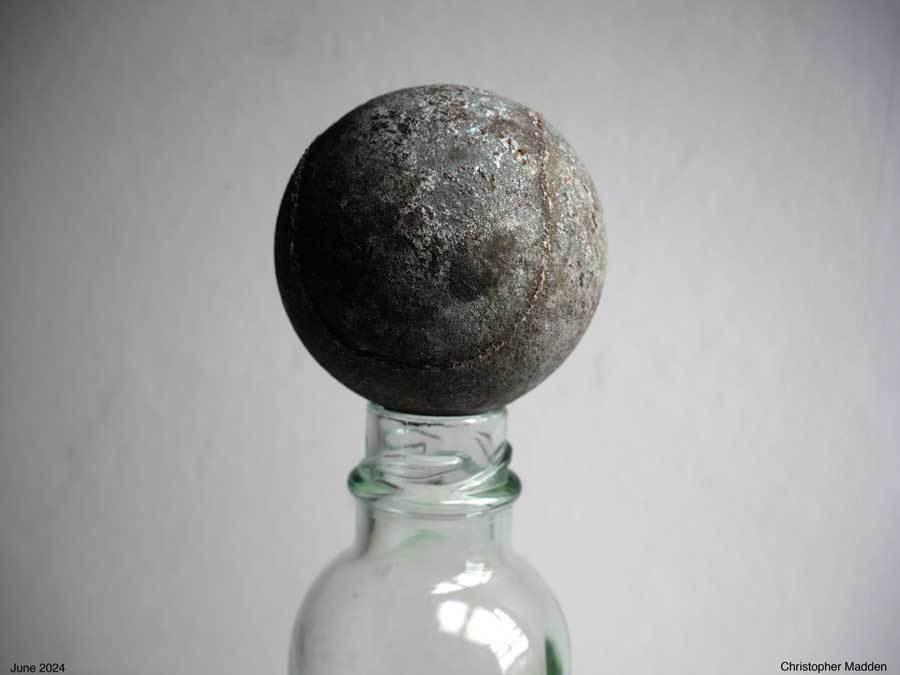

A sculptural work composed of coloured hemispheres reflected in a mirror to create the illusion of complete spheres.
The mirror is a front coated mirror so that there is no gap between the hemispheres resting on the surface of the mirror and the reflection.
The sculpture includes one complete sphere that creates the effect of a pair of spheres when reflected. This sphere is there for compositional purposes, but it fortuitously helps to emphasise the nature of the reflections of the hemispheres.
This work can be wall mounted or can be displayed horizontally.
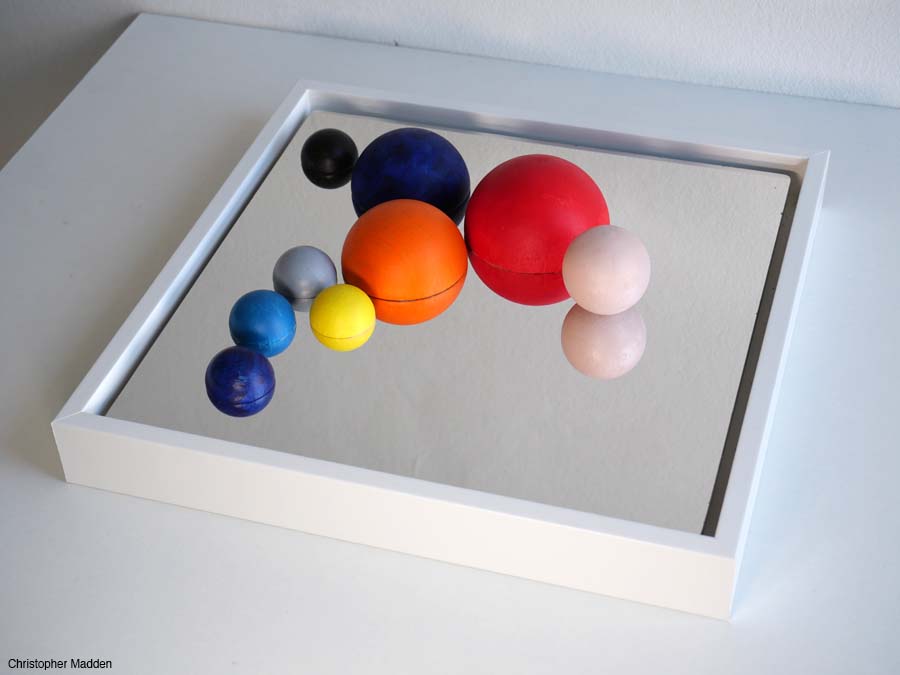
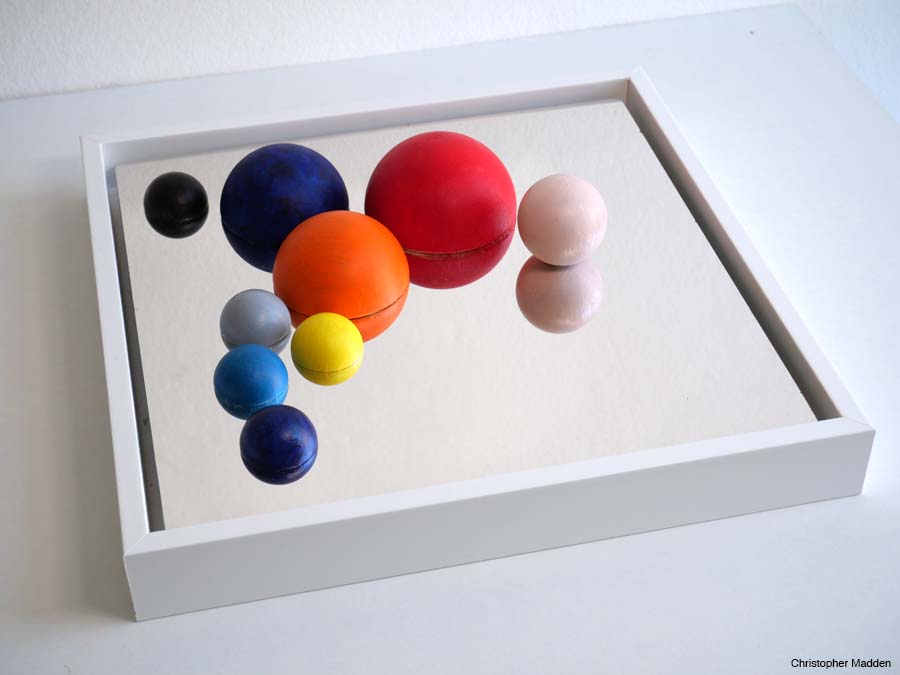
The work explores the themes of mirrors, reflections and illusions that have featured recurrently in my work over the decades.
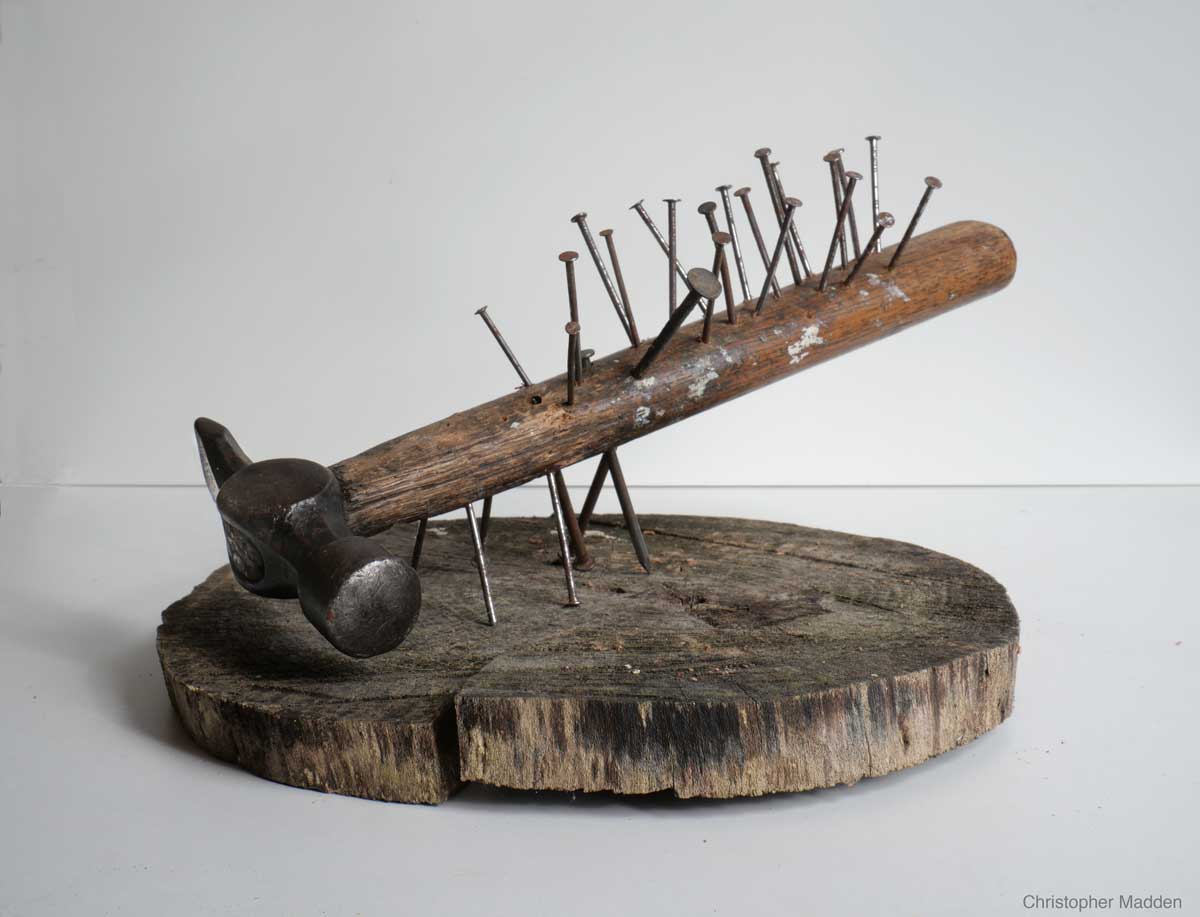
This sculpture was shown in the ING Discerning Eye exhibition in the Mall Galleries, London, November 2024. It is a work of political art, in the form of a metaphor for oppression and rebellion.
The work shows a hammer empaled by nails.
Part of the concept behind the sculpture is that the hammer is being impaled by the objects that it normally hits – the nails. The hammer is a symbol of oppression and dictatorship and the nails are symbols of the oppressed.
But the sculpture poses a question – how did the nails manage to drive themselves into the hammer? Nails by their nature need a hammer, or a stand-in for a hammer, in order to be effective and to fulfil their purpose. Were the nails hammered into the hammer by another hammer? In that case the nails are not a metaphor for the oppressed rising up against their oppressor (the hammer) using their own power, but are more like the followers of another power (another hammer?) that may turn out to be as oppressive as the hammer that they’ve empaled.
The leaders of liberation movements against repression often become oppressors or dictators in their turn.
This sculpture is a development of an idea that I had in 2010 when it started life as a drawing of a hammer with three nails driven into it.
Since then it developed into a 3D sculptural work composed of a hammer nailed directly onto a flat surface as though pinned down.
The iteration here has the hammer suspended above a surface and with many more nails driven into it so that it’s starting to resemble a nail fetish figure.
